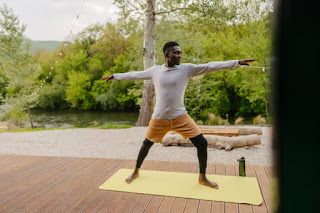Setting Intentions for the New Year: How Yoga and Meditation Can Help You Define Your Goals
Setting Intentions for the New Year: How Yoga and Meditation Can Help You Define Your Goals
As the New Year approaches, many of us feel the pull to set resolutions—to envision a fresh start, new goals, and a better version of ourselves. However, we often approach this time with the mindset of the hare in Aesop’s fable: we make bold, rapid changes only to burn out by February. This year, consider a different approach. Instead of chasing fleeting resolutions, let’s focus on intentions—clear, mindful goals aligned with our values that guide us steadily throughout the year. Using yoga and meditation as tools for reflection, we can ground our intentions in the present, allowing us to cultivate slow but meaningful progress, like the tortoise in the race.
Why Set Intentions Instead of Resolutions?
Resolutions often feel like rigid demands—things we think we should do, based on external expectations. They tend to focus on outcomes, like losing weight or advancing in our careers, rather than on the journey and growth along the way. Intentions, on the other hand, focus on aligning our actions with our personal values. They remind us of who we want to be, not just what we want to achieve. By setting intentions rooted in mindfulness, we approach the year with compassion, patience, and a steady path toward self-improvement.
In yoga and meditation, setting an intention is a way of connecting with your innermost desires and aligning your actions with your deeper self. When we bring mindfulness to this process, we clarify our priorities, making it easier to stay committed to our goals without the pressure of perfection.
Mindful Journaling to Set Intentions
To help you define your intentions for the New Year, start by reflecting on what’s most important to you. Mindful journaling is a powerful practice that allows you to tap into your inner voice and discover what truly matters. Use the following prompts to guide your reflection:
Journal Prompts:
- What are your top three intentions for the year?
- Think about areas of your life where you want to grow or improve. What are three key intentions that reflect your desires for the upcoming year? For example, your intention might be to cultivate self-compassion, deepen your yoga practice, or spend more time connecting with loved ones.
- How do these goals align with your values?
- Consider the values that are most important to you, such as kindness, health, or personal growth. How do your intentions reflect these core values? The more aligned your goals are with your values, the more meaningful and achievable they become.
- What would success look like for you by the end of the year?
- Visualize what it would feel like to have honored your intentions by the end of the year. Success doesn’t have to mean perfection; it might simply be a sense of growth, progress, or inner peace. Allow yourself to imagine what personal fulfillment looks like, rather than focusing solely on external achievements.
Visualizing Success Through Meditation
After journaling, a meditation practice can help you bring clarity and focus to your intentions. Visualization is a powerful tool that allows you to see your future self living in alignment with your goals. By visualizing success, you build a stronger connection to your intentions, making it easier to stay committed to them throughout the year.
Short Meditation for Visualizing Success:
- Find a Comfortable Seat: Sit in a quiet space where you won’t be disturbed. Close your eyes and take a few deep breaths, allowing your body to relax.
- Settle Your Mind: Begin by focusing on your breath, letting any distractions fade away. If your mind wanders, gently bring it back to the sensation of your breath.
- Visualize Your Future Self: Once you feel centered, start to visualize yourself at the end of the year. Imagine yourself having lived in alignment with your intentions—feeling calm, grounded, and fulfilled. What does your life look like? How do you feel? Picture yourself engaging in activities that reflect your values, such as practicing yoga, spending time with family, or nurturing your mental and physical health.
- Feel the Emotions of Success: As you visualize, focus on the emotions that arise. How does it feel to live a life aligned with your values? What sense of peace or accomplishment do you experience? Let those feelings wash over you, filling you with confidence in your ability to achieve your intentions.
- Conclude with Gratitude: As your meditation comes to an end, take a moment to thank yourself for taking this time to focus on your well-being. Open your eyes slowly and carry this sense of clarity with you as you move forward.
Grounding Intentions with Gentle Yoga
In addition to meditation, yoga offers a powerful way to embody your intentions. Through physical movement, you can ground your goals in the present moment, creating a strong foundation for growth. A gentle, mindful yoga flow can help you connect with your body, release any tension, and open yourself to the possibilities of the year ahead.
Yoga Flow for Grounding Intentions:
- Mountain Pose (Tadasana): Begin standing tall with your feet grounded firmly into the earth. Close your eyes and take a few deep breaths. Visualize yourself standing strong in your intentions, rooted like a mountain in your values.
- Forward Fold (Uttanasana): From Mountain Pose, hinge at your hips and fold forward, letting your head and arms hang toward the ground. Allow any mental or emotional tension to melt away, creating space for your intentions to take root.
- Warrior II (Virabhadrasana II): Step one foot back into Warrior II, grounding through your legs and hips. As you hold this strong, steady pose, focus on your commitment to your intentions. Picture yourself moving forward with determination and grace.
- Tree Pose (Vrksasana): From standing, shift your weight onto one leg and bring the sole of your opposite foot to your inner thigh or calf. Reach your arms overhead and focus on balancing. This pose reminds you to stay balanced and centered as you pursue your intentions throughout the year.
- Savasana (Corpse Pose): Finally, lie down on your mat and close your eyes. Let your body fully relax and absorb the energy of your practice. Allow yourself to rest in the present moment, knowing that you are exactly where you need to be.
Slow and Steady: The Tortoise’s Approach to Lasting Change
One of the reasons many resolutions fail is that we tend to approach change with an all-or-nothing mindset. We set unrealistic goals and expect immediate results, only to become frustrated when we don’t see instant success. Yoga and meditation teach us that lasting change is a gradual process. Just as the tortoise won the race by taking one slow step at a time, we too can achieve our intentions by approaching them with patience and perseverance.
Cultivating Patience:
- Set Small, Achievable Milestones: Break down your larger intentions into smaller, manageable steps. Rather than setting a vague goal like “be healthier,” start with something specific, such as practicing yoga for 10 minutes a day. Celebrate each small success along the way.
- Be Kind to Yourself: If you miss a day or fall off track, don’t be hard on yourself. Remember that progress is not linear, and setbacks are a natural part of the journey. Approach yourself with compassion, just as you would a friend.
- Stay Present: Focus on the process, not the outcome. Yoga teaches us to stay in the present moment, appreciating the small steps we take each day. By staying mindful, you’ll find that change happens naturally over time, without the need for drastic efforts.
Common Unhealthy Habits to Avoid
As we work toward our intentions, it’s important to recognize the unhealthy coping mechanisms or habits that can hinder our progress. Whether it’s procrastination, self-doubt, or perfectionism, these behaviors can derail our efforts if we’re not mindful of them.
Common Unhealthy Coping Mechanisms:
- Procrastination: Putting off your intentions until tomorrow is a common pitfall. Combat this by setting aside just 5-10 minutes a day to work toward your goals.
- Self-Doubt: Doubting your ability to achieve your intentions can hold you back. Practice self-compassion and remind yourself that you are capable of growth, no matter how small the steps.
- Perfectionism: The need to do everything perfectly can prevent you from even starting. Remember, progress is more important than perfection. Focus on showing up, even if it’s not perfect.
Check out our other articles on change and goal achievement
Aligning Your Goals with Your Values
Setting intentions for the New Year is about more than just achieving goals—it’s about aligning your actions with your values and creating a life that feels meaningful. By incorporating yoga and meditation into the process, you can ground your intentions in mindfulness, making it easier to stay committed to your goals throughout the year.
Remember, the key is to approach your intentions with patience, compassion, and a steady pace—just like the tortoise in Aesop’s fable. As you move through the year, stay present, be kind to yourself, and celebrate the small steps that bring you closer to your vision.









